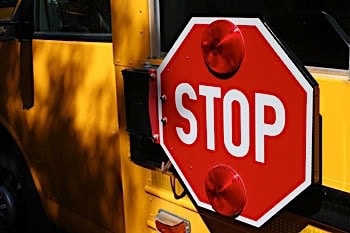The National Association of State Directors of Pupil Transportation Services updated its findings from its 2nd Annual School Bus Illegal Passing Driver Survey that indicates an increase in the number of motorists who blow past the school bus stop arm and flashing red lights despite fewer bus drivers participating.
NASDPTS President Mike Simmons reported the initial results at the Southeastern States Pupil Transportation Conference (SESPTC) in Biloxi, Miss. on July 9, a week after a provision passed the U.S. House of Representatives that would direct NHTSA to provide $10 million to states to enforce illegal passing laws. NASDPTS’ illegal-passing statistics were reference on the House floor. Originally, 26 states participated in the one-day count held from March 1 through May 31 of this year compared to 28 states last spring.
NASDPTS received two additional state responses this month, but Derek Graham, state director of student transportation at the North Carolina Department of Public Instruction and co-author of the survey, said the 28 states who participated this year differed from last year. The count originated fro a 1996 NAPT conference presentation made by Charlie Hood, state director at the Florida Department of Education. Hood reported results of the industry’s first statewide, one-day, stop-arm violation count conducted by the Florida’s Center for Urban Transportation Research.
The number of bus drivers who took part in the count while students loaded or unloaded the school bus fell to about 100,000 from 112,000 in 2011. Still, the total number of illegal passings rose to 39,760 from 37,756. Additionally, the state reports indicate that the total number of vehicles that illegally passed the school bus this year increased by nearly 12,000 to 88,025.
 NASDPTS said the results represent nearly 16 million violations by private motorists during a typical 180-day school year.
NASDPTS said the results represent nearly 16 million violations by private motorists during a typical 180-day school year.
During the July SESPTC presentation, NASDPTS President Mike Simmons, the senior transportation manager at the Arkansas Department of Education, explained that there were some discrepancies between incidents and actual passing vehicles. He said the figures were compiled from either standardized state reports or from different local district reports.
“This survey captured only a fraction of the violations that bus drivers and other professionals in school transportation and law enforcement know are occurring each and every morning and afternoon,” said Simmons added in a statement released today. “Students are far safer in school buses than the other ways they get to school, but when they are outside the bus, they are the most vulnerable. Any driver who passes a stopped school bus illegally is gambling with a child’s life.”
Half of the recorded incidents occurred on morning routes, up by half of a percent from last year. Meanwhile, 46 percent of the illegal passings occurred during afternoon routes, a one percent decrease from 2011. Also up a half a percent point from last year were the number of mid-day illegal passings at 4.5 percent.
The number of illegal passings from the front, or vehicles traveling toward the school bus, fell to 56 percent from 62 percent. Interestingly, the number of vehicles passing the bus from the rear increased to 44 percent from 38 percent. Nearly all of the incidents occurred on the left side of the bus, 98 percent compared to 97 percent last year. Right-side passings decreased to 2 percent from 3 pecent in 2011.
NASDPTS members resolved on Nov. 1, 2010 at the association’s annual meeting held in Portland, Ore., to conduct the survey each year and publish the results for the industry.
Also in July at the STN EXPO, cognitive researcher Shmuel Bollen of ACI Worldwide presented data on how the human eye perceives current markings on school buses. He theorized that changes to national standards could better explain the “Do Not Pass” message to other motorists by better labeling the bus in the area where the human eye is more frequently attracted to. After the presentation, several presenters commented to STN editors that they questioned why markings on the front of the bus are not also changed.
Read a related article in the September edition of School Transportation News magazine authored by Derek Graham, state director of student transportation with the North Carolina Department of Public Instruction and co-author of national illegal passing survey.
















